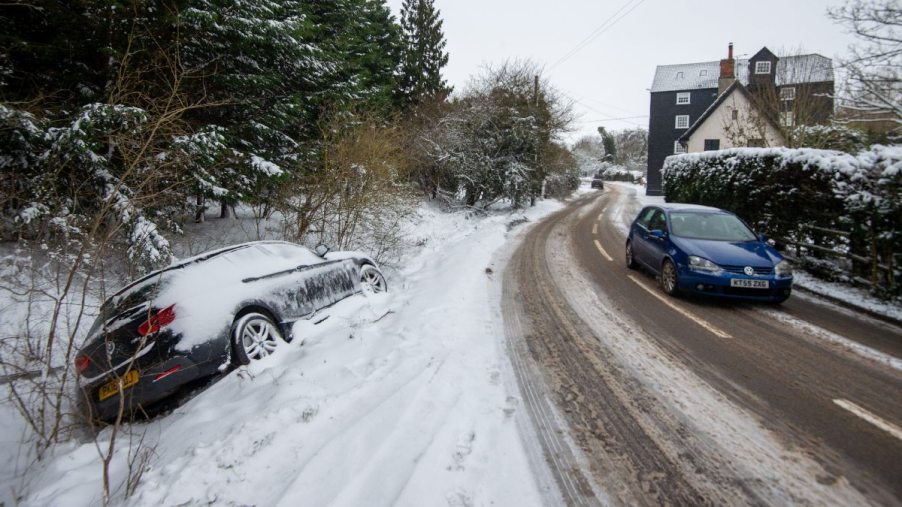
This Secret Trick Corrects Slide on Icy Road to Regain Control of Car
One of the most dangerous driving situations during the winter is a car that slides on a road with ice or snow. In my home state of Wisconsin, it’s not uncommon to see vehicles slide into the ditch. This is especially the case on the first snowstorm of the year — when drivers are a bit “rusty” with their winter driving skills. However, there’s a secret trick to correct a slide on an icy road so that you can regain control of your car. Read more to find out about this special technique.
How to prevent a car from sliding on a road with ice or snow

We’ll get to the secret trick in the next section, but first, let’s cover how you can prevent a car from sliding on a road with ice or snow. You can avoid it happening in the first place.
This mostly comes down to driving more slowly and avoiding any abrupt driving maneuvers. When drivers slide, also known as fishtailing, on an icy road and swerve into the ditch, it’s usually because they are driving too fast and aggressively for the conditions. They operate their car as if it’s a normal everyday driving situation.
However, on icy and snowy roads, you should limit your speed to 45 mph or less. Most slides and fishtails occur when driving at a speed of 45 mph or greater. It’s much more challenging to correct slides at higher speeds, for it requires precise and very quick steering. Furthermore, you should avoid any quick bursts of acceleration, abrupt braking, and sudden turns. All of these things increase the likelihood of sliding on ice and snow. Additionally, leave extra stopping distance behind other vehicles.
To correct fishtailing, ‘turn into a slide’ in the same direction that the rear of the car is sliding

OK, here’s the secret trick to correct a slide on an icy road so that you can regain control of your car. It’s called “turning into a slide.” While two types of slides are oversteer and understeer, the vast majority of cases are oversteer. And for oversteering, turning into the slide is an action that will fix the problem, as detailed by Icy Road Safety.
Turning into the slide means turning the steering wheel in the same direction that the rear of the car is sliding. This technique might sound counterintuitive, but it works. You can view this technique in the Icy Road Safety YouTube video below or in the above screenshot from the video.
If the back of your car slides to the left, then turn the steering wheel to the left. And if it veers to the right, turn it to the right. Once your vehicle straightens out on the road, straighten the steering wheel.
Other tips to help you safely fix a slide on icy or snowy roads
In addition to turning into a slide, there are two other important tips that you should follow. The first is to not panic and overcorrect your steering. Be careful to only turn the steering wheel in proportion to the amount of force your car is sliding. If your vehicle fishtails only a little, then only a minor steering adjustment is needed.
A common mistake when turning into a slide is overcorrection. People turn the steering wheel too aggressively, resulting in a car snapping back in the opposite direction. Sometimes a vehicle oscillates multiple times before it straightens out and stabilizes. The key is to calmly keep your focus on the road ahead and pay close attention to any necessary steering adjustments to stabilize your car.
Another frequent mistake when drivers slide their cars on icy and snowy roads is braking. Not only can braking cause a slide, but it can also significantly worsen it. In order for a slide correction to be effective, you need to keep your foot off the brakes. The wheels on your vehicle must be able to move freely.
Hopefully, this slide correction advice is helpful for you when driving on roads with ice or snow. Stay safe this winter!





